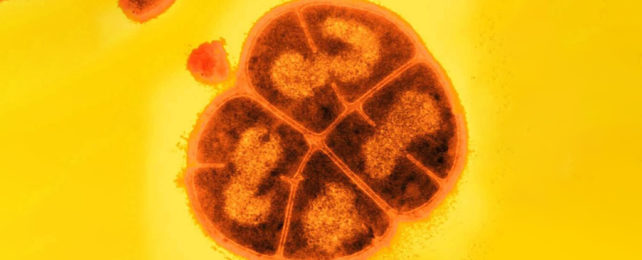Here on Earth, life finds a way in some of our most extreme and unlikely environments, so it's possible that microbial life may have once eked a living on our neighboring red planet, too.
New laboratory simulations replicating some of the extreme conditions such life would have encountered suggest signs of these microbes may still remain, safely tucked under meters of Martian mineral soil, for future rovers, like ExoMars, to find.
This is despite the challenges any such ancient life would have faced on what is now a desolate, freezing, and essentially airless planet – not to mention the difficulties we might have in recognizing them.
"If Martian life ever existed, even if viable lifeforms are not now present on Mars, their macromolecules and viruses would survive much, much longer," says Uniformed Services University pathologist Michael Daly.
"That strengthens the probability that, if life ever evolved on Mars, this will be revealed in future missions."
Daly and colleagues exposed six microbes – including the most radiation-resistant bacteria known, Deinococcus radiodurans, and the yeast Saccharomyces cerevisiae – to the dry and frigid -80 °C (-112 °F) conditions similar to those found on Mars.
"There is no flowing water or significant water in the Martian atmosphere, so cells and spores would dry out," says Northwestern University chemist Brian Hoffman.
"It also is known that the surface temperature on Mars is roughly similar to dry ice, so it is indeed deeply frozen."
The team bombarded the dried and frozen bacteria and fungi with gamma rays and protons to simulate cosmic radiation.
Mars lacks the protection against cosmic radiation that we're incredibly fortunate to have here on Earth. Our atmosphere and planet's magnetic field deflect most of this radiation before it reaches us on the surface, so that over a year the dose we receive is similar to that of two chest x-rays.
In contrast, if we were on the red planet's surface we would be bathed in 40-50 times more radiation – that's a lethal dose within six months.
This level of radiation can mess with amino acids, the basic building blocks of all life, and previous research found it would take 2 meters (6.6 feet) of ground to protect these molecules for about 80 million years - if we're lucky.
Yet Mars has been inhospitable to life as we know it for billions of years now, meaning that any trace of it would have disintegrated beyond our reach.
In the new study, however, the researchers demonstrated that the dried-out and frozen D. radiodurans could survive much longer than previous estimates. This bacteria was so impressively robust the team nicknamed it Conan the Bacteria.
Based on their data, the team posits that Conan the Bacteria could survive 1.5 million years under a mere 10 centimeters of Mars dirt, and a whopping 280 million years if it were huddled 10 meters under the surface.
"Although D. radiodurans buried in the Martian subsurface could not survive dormant for the estimated 2 to 2.5 billion years since flowing water disappeared on Mars, such Martian environments are regularly altered and melted by meteorite impacts," explains Daly.
"We suggest that periodic melting could allow intermittent repopulation and dispersal."
This raises the possibility of cross-contamination of life on both Mars and Earth, which would require planetary protection measures to prevent, Horne and colleagues caution.
"We concluded that terrestrial contamination on Mars would essentially be permanent – over timeframes of thousands of years," says Hoffman.
"This could complicate scientific efforts to look for Martian life. Likewise, if microbes evolved on Mars, they could be capable of surviving until present day. That means returning Mars samples could contaminate Earth."
All up, their research suggests there's still a chance, albeit a very slim one, that future rovers may be able to reach some traces of ancient microbial Mars life. That is, of course, assuming that such life was similar enough to that which we are familiar with, if it ever even existed at all.
This research was published in Astrobiology.
